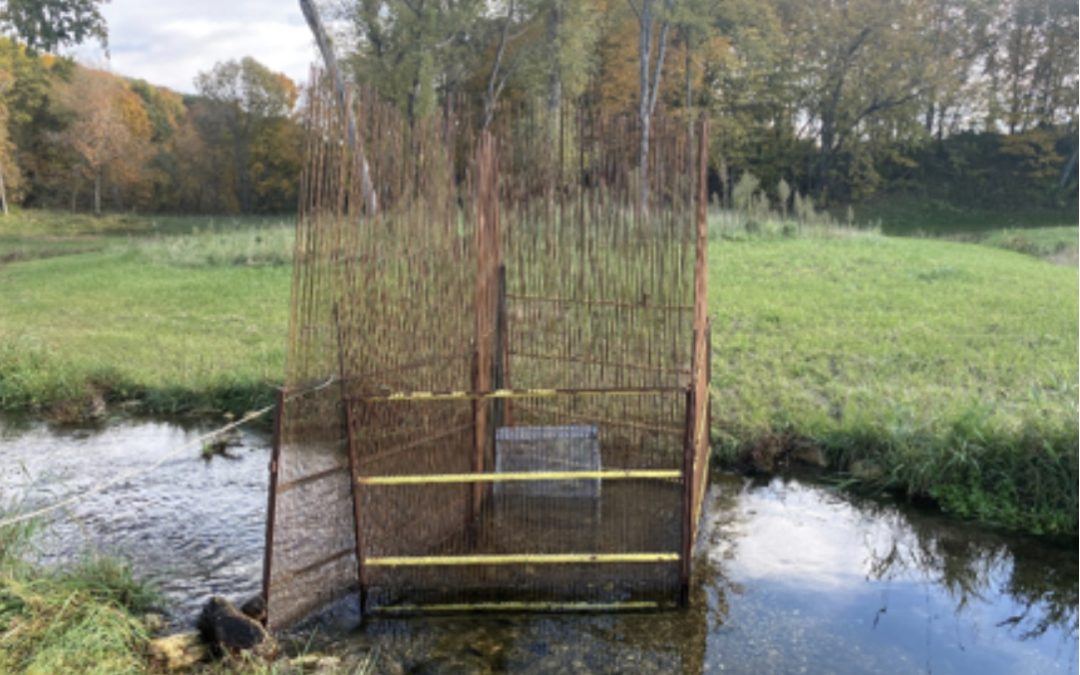Restoring Cady Creek’s Brook Trout Population by Managing the Eau Galle River Watershed – PART 2
Kasey Yallaly
Back in 2020, I wrote an article about our brook trout restoration efforts in Cady Creek. If you dig this article up from the archives, you will see that we have come a long way since 2018. To refresh everyone’s memories-the brook trout population in Cady Creek was in extreme decline following the invasion of brown trout in 2006. Brown trout densities continued to increase to the point that they surpassed brook trout densities up until our removal efforts began in 2018. We have documented the exclusion of brook trout by brown trout in several other streams, to the point where brook trout are almost completely gone. In order to prevent this from occurring in Cady Creek, we began with removing brown trout from Cady in 2018 and have continued every fall since then.
I have good news to share if you are a brook trout fan- we have documented a strong positive response of brook trout to our brown trout removal efforts. Brook trout densities and natural reproduction continue to increase. Brown trout have continued to decline, and we removed the fewest brown trout to date in 2023. Brown trout densities have dropped from a high in 2021 of 1,891/mile to 439/mile in 2023 (see graph).
Catch rates of brook and brown trout in Cady Creek at the Station 2 trend site.
Each fall, we use electrofishing gear to remove brown trout in about 4.5 miles of Cady Creek. This year, we removed a total of 1,582 brown trout with 66% of those fish being young-of-year brown trout or trout that hatched this past spring. From this data, we know that adult brown trout from the Eau Galle River are utilizing Cady Creek as a spawning and nursery stream. Unfortunately, there is no barrier that prevents brown trout from moving into Cady Creek in the fall to spawn and it would be impossible to create a permanent barrier because of the relatively low gradient of lower Cady Creek, meaning that a barrier would cause water to back up for a long length of stream which would severely degrade habitat and water quality. Therefore, to create a temporary barrier, we were able to acquire part of a weir from another fisheries team in Peshtigo, that will help us create a temporary barrier.
Weir installed in lower Cady Creek in 2022
This type of weir is designed to allow water to pass through while directing trout that are moving upstream into a trap. Any fish caught in the trap can then be moved upstream or downstream or removed. We placed the weir in lower Cady in early fall of 2022. No fish were trapped but the weir did act as a barrier to upstream passage. Leaf debris was an issue, which meant that the weir needed to be cleaned twice a day.
In order to narrow down an appropriate timeframe to operate the weir, we needed to know more about seasonal trout movement. Therefore, we teamed up with Matt Mitro’s (DNR Research Scientist) research crew to devise a trout movement project. Matt is also interested in brook and brown trout passage through beaver dams and with several new beaver dams popping up on Cady Creek, a project fell into place that could help to answer both of our questions. We installed 2 PIT tag arrays in Cady Creek upstream and downstream of a beaver dam. PIT tag arrays are basically a series of wires that are installed within the stream that will detect fish that are tagged with PIT tags. These are passive arrays, meaning that no active tracking of fish is needed. Each time a fish that is tagged passes through the array, the array detects that specific tag number and records that information along with the date and time that the fish passed by. We PIT tagged a total of 862 brown and brook trout within the Eau Galle and Cady Creek to track seasonal movements of fish and gain additional data on growth rates. PIT tags are the same thing that dogs and cats are “microchipped” with, and each animal’s tag is a unique number.
The data collected from this project will help inform us as to when the weir should be installed within Cady Creek to prevent brown trout moving upstream into Cady from the Eau Galle River to spawn. This will reduce the amount of effort needed to remove brown trout each year and will reduce the number of brown trout removed overall. Brown trout removals will also continue each fall. Trout fishing regulations were also recently changed and a new regulation for Cady and Pine Creeks will go into effect on fishing opener of 2024. The new regulation is a daily bag limit of 5 fish with no length limit for brown trout and all brook trout shall be immediately released. Anglers are highly encouraged to harvest brown trout in these streams! PIT tags were inserted into the body cavities of the trout, so no need to worry about crunching into a PIT tag when you eat a filet!


